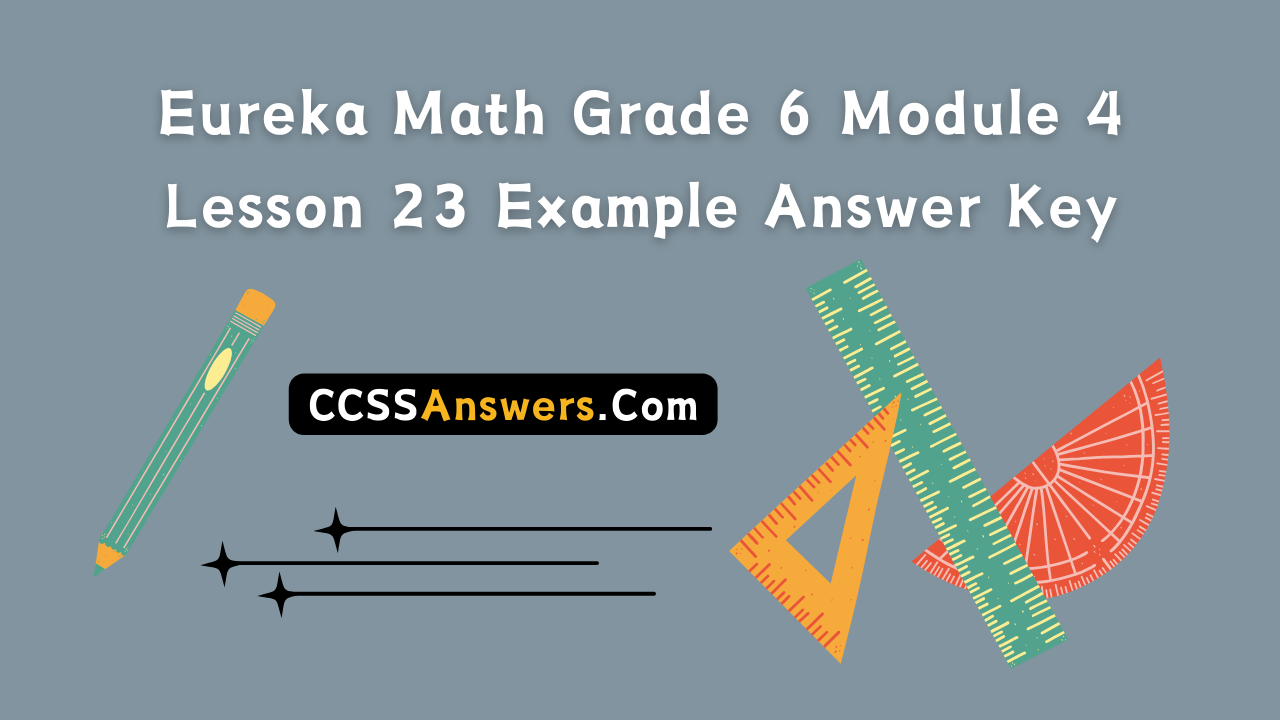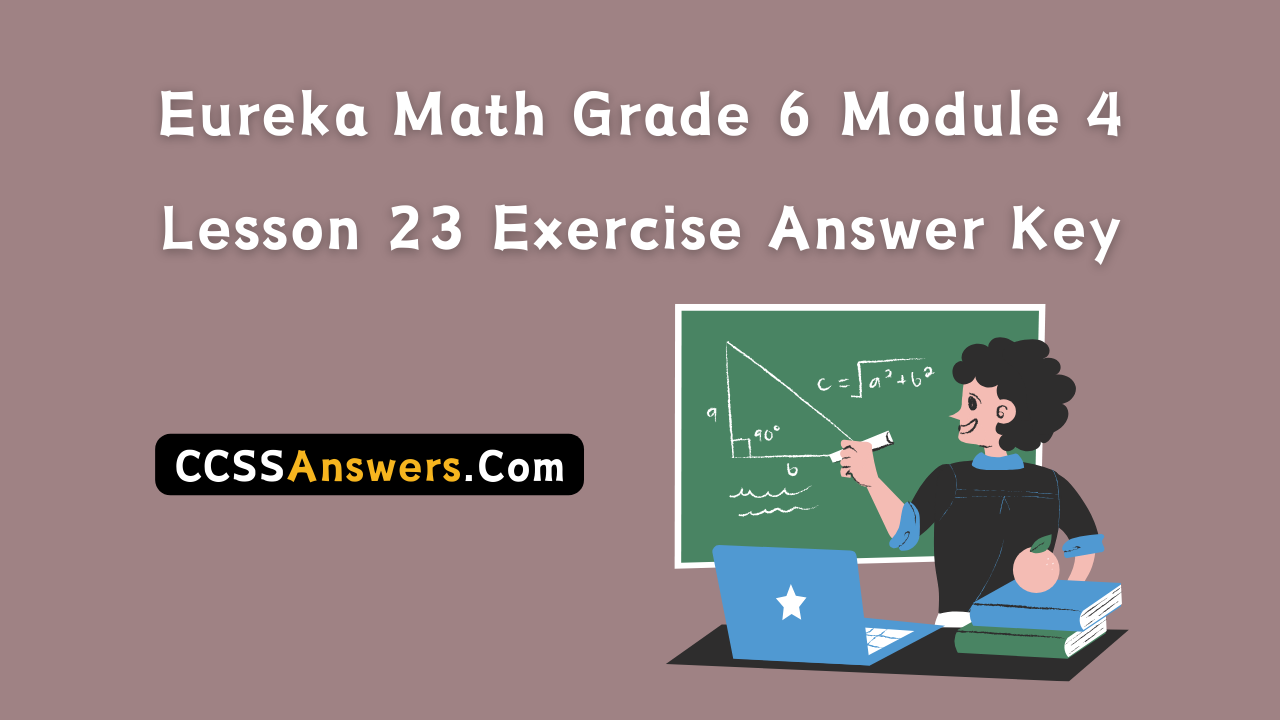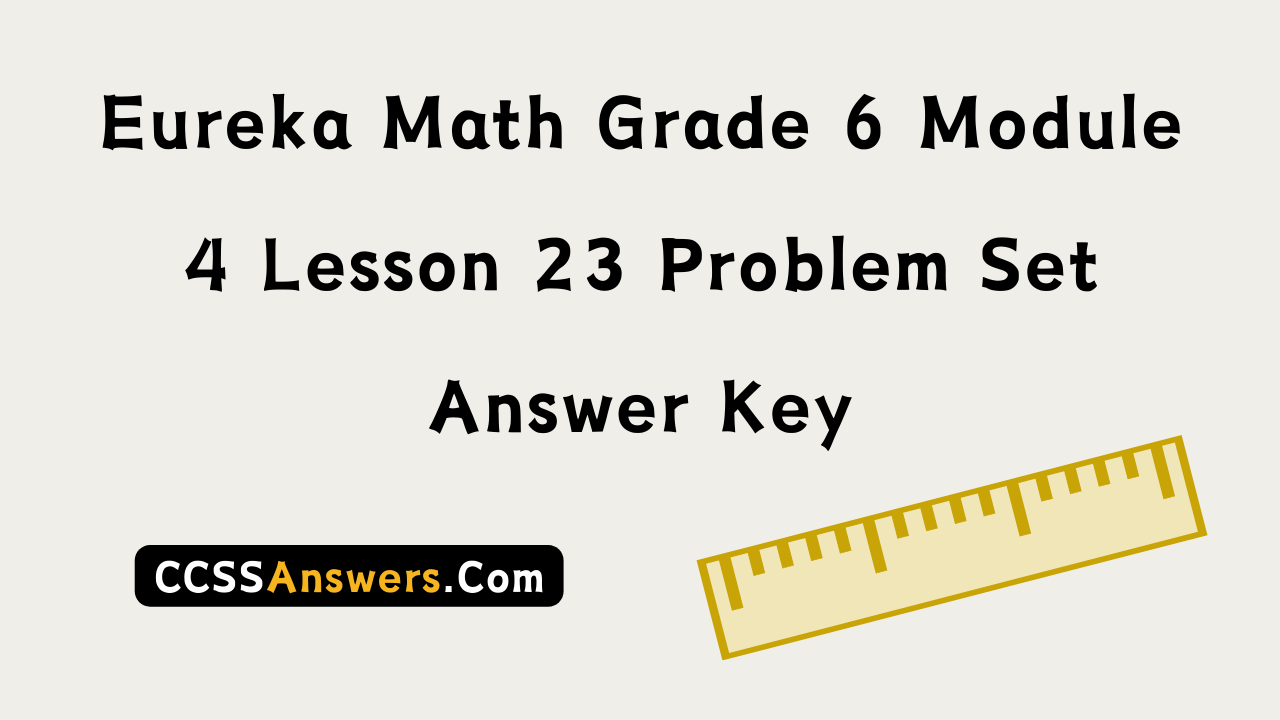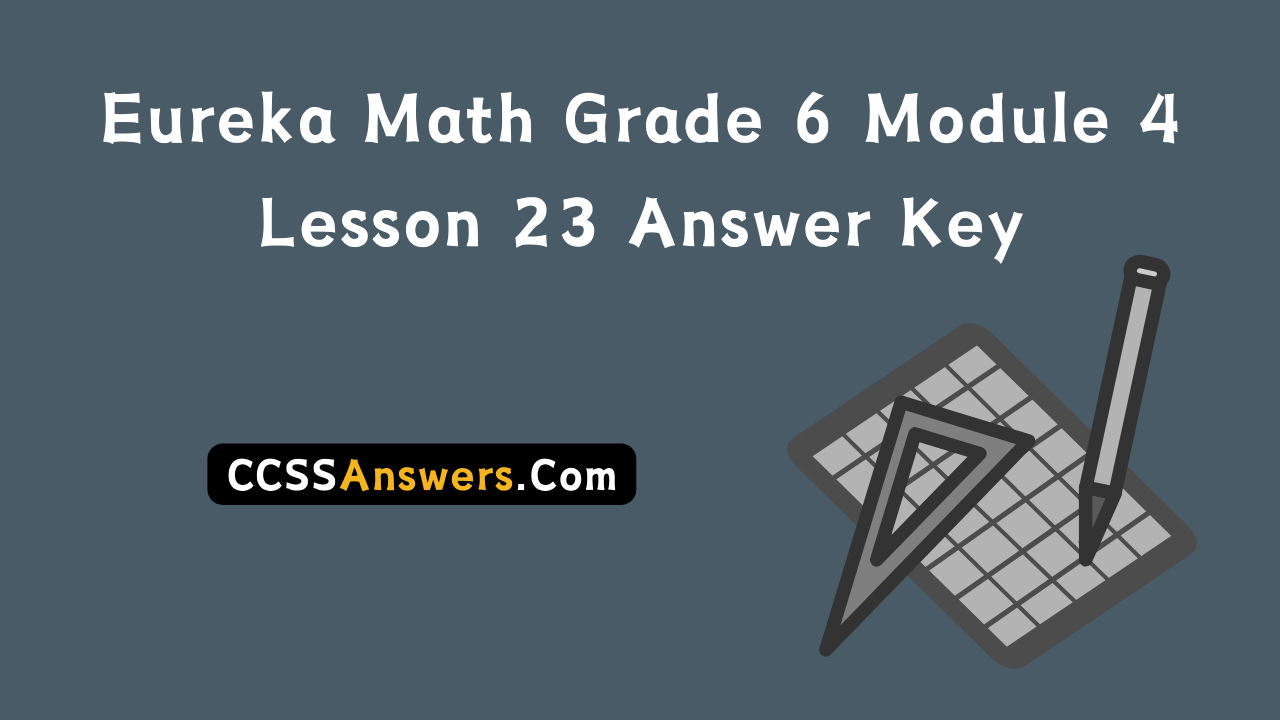Engage NY Eureka Math Grade 6 Module 4 Lesson 23 Answer Key
Eureka Math Grade 6 Module 4 Lesson 23 Opening Exercise Answer Key
Opening Exercise:
Determine what each symbol stands for, and provide an example.

Answer:

→ What is another example of a number sentence that includes an equal symbol?
Answers will vary. Ask more than one student.
The student’s height is the height marked by the tape on the wall. Have students stand next to the marked height. Discuss how their heights compare to the height of the tape. Are there other students in the room who have the same height?
![]()
Use the student’s height measurement in the example (the example uses a student 4\(\frac{7}{8}\) ft. in height).
→ What is another example of a number sentence that includes a greater than symbol?
Answers will vary. Ask more than one student.
Have students taller than the tape on the wall stand near the tape. Discuss how more than one student has a height that is greater than the tape, so there could be more than one number inserted into the inequality: > 4\(\frac{7}{8}\).
![]()
→ What is another example of a number sentence that includes a less than symbol?
Answers will vary. Ask more than one student.
Have students shorter than the tape on the wall stand near the tape. Discuss how more than one student has a height that is less than the tape, so there could be more than one number inserted into the inequality: < 4\(\frac{7}{8}\).
![]()
→ What is another example of a number sentence that includes a less than or equal to symbol?
Answers will vary. Ask more than one student.
Ask students who are the exact height as the tape and students who are shorter than the tape to stand near the tape. Discuss how this symbol is different from the previous symbol.
![]()
→ What is another example of a number sentence that includes a greater than or equal to symbol?
Answers will vary. Ask more than one student.
→ Which students would stand near the tape to demonstrate this symbol?
Students who are the same height as or taller than the tape
Eureka Math Grade 6 Module 4 Lesson 23 Example Answer Key

For each equation or inequality your teacher displays, write the equation or inequality and then substitute 3 for every x. Determine if the equation or inequality results in a true number sentence or a false number sentence.
Answer:
Display 5 + x = 8.
→ Substitute 3 for x and evaluate. Does this result in a true number sentence or a false number sentence?
True
→ Why is the number sentence a true number sentence?
Each expression on either side of the equal sign evaluates to 8. 8 = 8
Display 5x = 8.
→ Substitute 3 for x and evaluate. Does this result in a true number sentence or a false number sentence?
False
→ Why is the number sentence a false number sentence?
Five times three equals fifteen. Fifteen does not equal eight, so the number sentence 5(3) = 8 is false.
Display 5 + x > 8.
→ Substitute 3 for x and evaluate. Does this result in a true number sentence or a false number sentence?
False
→ Why is the number sentence a false number sentence?
Each expression on either side of the in equality sign evaluates to 8. However, the inequality sign states that eight is greater than eight, which is not true. We have already shown that 8 = 8.
Display 5x > 8.
→ Substitute 3 for x and evaluate. Does this result in a true number sentence or a false number sentence?
True
→ Why is the number sentence a true number sentence?
When three is substituted, the left side of the inequality evaluates to fifteen. Fifteen is greater than eight, so the number sentence is true.
Display 5 + x ≥ 8.
→ Substitute 3 for x and evaluate. Does this result in a true number sentence or a false number sentence?
True
→ Why is the number sentence a true number sentence?
Each expression on either side of the inequality sign evaluates to 8. Because the inequality sign states that the expression on the left side can be greater than or equal to the expression on the right side, the number sentence is true because we have already shown that 8 = 8.
→ Can you find a number other than three that we can substitute for x that will result in a false number sentence?
Answers will vary, but any number less than three will result in a false number sentence.
Eureka Math Grade 6 Module 4 Lesson 23 Exercise Answer Key

Exercises:
Substitute the indicated value into the variable, and state (in a complete sentence) whether the resulting number sentence is true or false. If true, find a value that would result in a false number sentence. If false, find a value that would result in a true number sentence.
Exercise 1.
4 + x = 12. Substitute 8 for x.
Answer:
When 8 is substituted for x, the number sentence is true.
Answers will vary on values to make the sentence false; any number other than 8 will make the sentence false.
Exercise 2.
3g > 15. Substitute 4\(\frac{1}{2}\) for g.
Answer:
When 4\(\frac{1}{2}\) is substituted for g, the number sentence is false.
Answers will vary on values that make the sentence true; any number greater than 5 will make the sentence true.
Exercise 3.
\(\frac{f}{4}\) < 2. Substitute 8 for f.
Answer:
When 8 is substituted for f, the number sentence is false.
Answers will vary on values to make the sentence true; any number less than 8 will make the sentence true.
Exercise 4.
14.2 ≤ h – 10.3. Substitute 25.8 for h.
Answer:
When 25.8 is substituted for h, the number sentence is true.
Answers will vary on values to make the sentence false; any number less than 24.5 will make the sentence false.
Exercise 5.
4 = \(\frac{8}{h}\). Substitute 6 for h.
Answer:
When 6 is substituted for h, the number sentence is false.
2 is the only value that will make the sentence true.
Exercise 6.
3 > k + \(\frac{1}{4}\). Substitute 1\(\frac{1}{2}\) for k.
Answer:
When 1\(\frac{1}{2}\) is substituted for k, the number sentence is true.
Answers will vary on values to make the sentence false; the number 2\(\frac{3}{4}\) or any number greater than 2\(\frac{3}{4}\) will make the sentence false.
Exercise 7.
4.5 – d > 2.5. Substitute 2.5 for d.
Answer:
When 2.5 is substituted for d, the number sentence is false.
Answers will vary on values to make the sentence true; any number less than 2 will make the number sentence true.
Exercise 8.
8 ≥ 32p. Substitute for \(\frac{1}{2}\)p.
Answer:
When \(\frac{1}{2}\) is substituted for p, the number sentence is false.
Answers will vary on values to make the sentence true; the number \(\frac{1}{4}\) or any number less than \(\frac{1}{4}\) will make the sentence true.
Exercise 9.
\(\frac{w}{2}\) < 32. Substitute 16 for w.
Answer:
When 16 is substituted for p, the number sentence is true.
Answers will vary on values to make the sentence false; the number 64 or any other number greater than 64 will make the sentence false.
Exercise 10.
18 ≤ 32 – b. Substitute 14 for b.
Answer:
When 14 is substituted for b, the number sentence is true.
Answers will vary on values to make the sentence false; any number greater than 14 will make the sentence false.
Eureka Math Grade 6 Module 4 Lesson 23 Problem Set Answer Key

Substitute the value for the variable, and state (in a complete sentence) whether the resulting number sentence is true or false. If true, find a value that would result in a false number sentence. If false, find a value that would result in a true number sentence.
Question 1.
3\(\frac{5}{6}\) = 1-+h. Substitute 2\(\frac{1}{6}\) for h.
Answer:
When 2\(\frac{1}{6}\) is substituted in for h, the number sentence is true. Answers will vary, but any value for h other than 2\(\frac{1}{6}\) will result in a false number sentence.
Question 2.
39 > 156g. Substitute \(\frac{1}{4}\) for g.
Answer:
When \(\frac{1}{4}\) is substituted in for g, the number sentence is false. Answers will vary, but any value for g less than \(\frac{1}{4}\) will result in a true number sentence.
Question 3.
\(\frac{f}{4}\) ≤ 3. Substitute 12 for f.
Answer:
When 12 is substituted in for f, the number sentence is true. Answers will vary, but any value for f greater than 12 will result in a false number sentence.
Question 4.
121 – 98 ≥ r. Substitute 23 for r.
Answer:
When 23 is substituted in for r, the number sentence is true. Answers will vary, but any value for r greater than 23 will result in a false number sentence.
Question 5.
\(\frac{54}{q}\) = 6. Substitute 10 for q.
Answer:
When 10 is substituted in for q, the number sentence is false. The number 9 is the only value for q that will result in a true number sentence.
Create a number sentence using the given variable and symbol. The number sentence you write must be true for the given value of the variable
Question 6.
Variable: d Symbol: ≥ The sentence is true when 5 is substituted for d.
Answer:
Question 7.
Variable: y Symbol: ≠ The sentence is true when 10 is substituted for y.
Answer:
Question 8.
Variable: k Symbol: < The sentence Is true when 8 is substituted for k.
Answer:
Question 9.
Variable: a Symbol: < The sentence is true when 9 is substituted for a.
Answer:
Answers will vary for Problems 6 – 9.
Eureka Math Grade 6 Module 4 Lesson 23 Exit Ticket Answer Key
Substitute the value for the variable, and state in a complete sentence whether the resulting number sentence is true or false. If true, find a value that would result in a false number sentence. If false, find a value that would result in a true number sentence.
Question 1.
15a ≥ 75. Substitute 5 for a.
Answer:
When 5 is substituted in for a, the number sentence is true. Answers will vary, but any value for a less than 5 will result in a false number sentence.
Question 2.
23 + b = 30. Substitute 10 for b.
Answer:
When 10 is substituted in for b, the number sentence is false. The only value for b that will result in a true number sentence is 7.
Question 3.
20 > 86 – h. Substitute 46 for h.
Answer:
When 46 is substituted in for h, the number sentence will be false. Answers will vary, but any value for h greater than 66 will result in a true number sentence.
Question 4.
32 > 8m. Substitute 5 for m.
Answer:
When 5 is substituted in for m, the number sentence is false. Answers will vary, but the value of 4 and any value less than 4 for m will result in a true number sentence.
